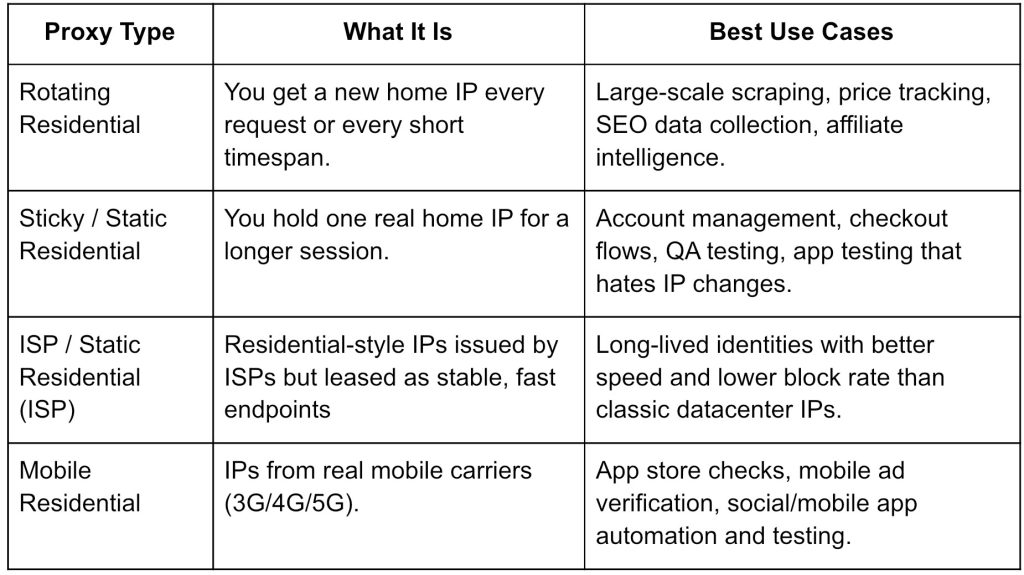Residential proxies are IP addresses that come from real consumer devices — actual laptops, smartphones, routers — instead of commercial data centers. That means when you connect through a residential proxy, websites see you as a normal household user, not automated infrastructure. This is powerful for anyone who needs reliable data collection, accurate geo-targeting, or steady multi-account management without getting rate limited, instantly blocked, or forced into endless CAPTCHAs. Residential IPs are simply harder to detect and blacklist than data center IPs, because they look “natural.”
What changed in 2025 is not the definition, but the expectations. The bar is higher now. Sites are smarter, anti-bot systems are more aggressive, and shallow proxy pools get flagged fast. Good residential proxy providers in 2025 don’t just “rent you IPs.” They give you: massive global IP pools, flexible rotation rules, sticky sessions when you need consistency, clean IP reputation, and usage-based pricing that doesn’t punish you for scaling up or down.

In other words, choosing “the best” provider this year is less about a brand name and more about matching the exact job you’re trying to do — from scraping travel or ecommerce data at scale, to verifying ads, to running localized QA tests across dozens of cities.
How Residential Proxies Work Behind the Scenes
Here’s the simple version. You connect to a gateway provided by the proxy service. That gateway routes your traffic through one of the IPs in their residential pool. Some providers rotate that IP on every single request; others let you “pin” an IP and hold it for 10 minutes, 30 minutes, or even hours. This is the difference between rotating sessions (new IP each call) and sticky sessions (keep the same IP for longer). Rotating behavior is great for web scraping tasks that send thousands of parallel requests because it spreads traffic across many residential IPs and keeps you from triggering rate limits. Sticky behavior is better for logged-in workflows, carts, sign-ups, or anything needing a consistent identity.
Most mature 2025 providers let you choose rotation mode, location (country, city, sometimes even ASN), and protocol (usually HTTP(S) and SOCKS5). This matters because you shouldn’t have to rewrite your whole stack just to test an app from Paris or collect price data “as if” you were in Texas. Providers that understand that flexibility are the ones winning this year.
Key Things to Look For When Choosing a Residential Proxy Provider in 2025
A lot of people ask, “Who’s the best?” That’s like asking “What’s the best car?” The honest answer is: it depends if you’re racing, hauling, or commuting. Let’s break down the real decision points that matter this year:
- IP pool size and cleanliness. A huge pool (tens of millions of active IPs) across many countries gives you more variety and a lower chance of recycled or burned addresses. Leading 2025 players advertise pools in the tens or even hundreds of millions of residential IPs across 100+ countries for coverage at scale.
- Rotation control. Can you force rotation every request? Can you hold an IP for 10+ minutes for login flows? Can you request a sticky residential IP that behaves like a regular home user from a specific city? Strong providers expose both rotating and static/ISP-style residential options.
- Geo-targeting depth. Country-level targeting is standard now. City-level (or even ASN-level) targeting is what you want if you’re testing local ads, local SERPs, or marketplace pricing. Enterprise-grade vendors offer this granularity.
- Pricing model. Some services charge per GB of traffic. Others sell “ports” or “threads” with unlimited bandwidth. Per-GB pricing is usually more predictable for scraping and analytics. Port-based pricing can be cheaper for niche, low-volume tasks but harder to scale.
- Speed and success rate. You don’t just want “fast.” You want “fast enough without getting blocked.” The best residential proxy in 2025 is the one that quietly does the job without constant retries and roadblocks. That’s usually what you pay for.
If you keep those five criteria in mind, you can quickly tell whether a provider is just reselling the same tired IP pool or actually delivering a serious commercial-grade network.
Top Residential Proxy Providers in 2025 (Who Stands Out and Why)
Let’s walk through the leading names people actually use in 2025. We’ll look at what each one is good at instead of pretending there’s one single winner for everyone.
Proxys.io — Flexible Traffic-Based Residential Plans and Practical Rotation
Proxys.io offers residential proxies with a pay-per-traffic model. You pay for the data you consume instead of pre-buying a fixed number of IPs or being forced into rigid time windows. That’s attractive if your workload is seasonal or bursty — for example, heavy data collection on certain days, light monitoring the rest of the month. The service supports both rotating residential IPs (new IPs each request or session for stealth and scale) and static/“sticky” residential IPs sourced from real ISPs for workflows that need to look like a consistent household connection.
From a technical standpoint, this dual approach is important. Rotating residential IPs help with aggressive scraping, anti-bot walls, and high-volume analytics. Sticky residential IPs are better for account-based actions, browser automation, and QA testing where a constantly changing IP would break the session. Having both modes in one dashboard means you don’t need to juggle multiple vendors just to run different parts of your pipeline.
Another angle here is pricing clarity. Proxys.io publicly advertises transparent rates, with residential options starting from a traffic-based model (per GB), plus other proxy types like mobile and dedicated IPv4. This makes it approachable for solo operators and small teams that can’t justify an enterprise invoice but still need real residential IP quality.
Bright Data — Enormous Global Coverage and Enterprise Controls
Bright Data (formerly Luminati) is known for raw scale: a massive residential pool, deep geo-targeting, and surgical rotation control. The company markets advanced rotation logic where you can swap IPs per request or stick to one IP for a defined time span. You can even tune rotations based on conditions like response code. This kind of granular control is valuable for enterprise scraping, competitive intelligence, and ad verification across dozens of markets because it lets you behave like “real local users” in many regions without constant manual babysitting.
The trade-off? Cost. Bright Data is often positioned toward well-funded teams, agencies, and enterprises. You’re paying for the toolkit, compliance framework, analytics, and reliability at scale. If you’re managing thousands of concurrent threads and need guaranteed reach across 150+ million IPs, this level of sophistication might be worth it. If you’re just running light keyword tracking, it might be overkill.
Decodo (formerly Smartproxy) — Strong Balance of Speed, Control, and Support
Decodo (the rebranded Smartproxy line) markets itself as a middle ground: fast residential and ISP (static residential) IPs, over 100M+ addresses across ~195 locations, and good tooling like browser automation support and scraping APIs. Their pitch in 2025 is “easy to start, strong enough for business.” You get both dynamic rotating residential IPs and long-lived sticky/ISP residential IPs, plus helpful dashboards, customer support via chat, and even money-back guarantees or trials on certain plans.

Where Decodo shines is session control. You can hold an IP for a longer window — which is critical for managing accounts, posting content, QA testing, or any workflow that falls apart if your identity changes mid-session. At the same time, you can still spin high-volume rotating traffic for scraping or data extraction. The catch is pricing: it’s friendly at scale, but small buyers may feel the price-per-GB isn’t “cheap,” especially if they aren’t using the full data allotment.
Oxylabs — Heavy-Duty Scraping and Advanced Targeting
Oxylabs leans into large-scale web scraping, SERP intelligence, price monitoring, and enterprise data gathering. They’re known for offering rotating residential proxies, mobile IPs, and scraping-focused tooling (like pre-built scrapers and “unblocker” style solutions) rather than just raw IP access. For many enterprise users in 2025, this is attractive because they don’t just want IPs — they want results: clean data, low block rate, and the ability to aim traffic at very specific locations and even specific networks.
If you’re running thousands (or tens of thousands) of parallel requests across multiple regions per minute, Oxylabs is built for that. The downside is that it can feel like a big machine. You’re buying power tools. For a lean marketing team that just needs to check ad creatives in three cities, it may be more than you need.
IPRoyal / ProxyEmpire / Storm Proxies — Budget-Friendly and Niche Options
Not everyone needs a giant platform. Some teams just want something affordable that works “well enough” in specific regions.
- IPRoyal / ProxyEmpire: These brands position themselves as cost-effective residential proxy sources with solid global reach and entry-level pricing tiers. ProxyEmpire in particular advertises millions of IPs and coverage in 170+ countries, aiming at users who want rotating residential IPs without enterprise spend.
- Storm Proxies: Storm Proxies is more old-school and budget-friendly. It typically sells rotating residential IPs “per port,” with automatic rotation every few minutes and unlimited bandwidth. That model is appealing if you don’t want to think about per-GB billing, but you’re okay with a smaller IP pool that’s mostly US/EU. It’s practical for lighter scraping, SERP checks, or small ecom research, but you won’t get deep analytics dashboards or instant live chat.
These providers can be perfect stepping stones. You get working residential IPs and rotation without committing to an expensive enterprise contract. Just remember: smaller pool = higher chance that certain IPs have been used before, which can lead to more captchas and occasional throttling on sensitive targets.
Residential vs. Rotating vs. Static ISP: Which One Do You Actually Need?
It’s easy to get lost in terminology, so let’s simplify the most common proxy modes you’ll see in 2025:

The smart move is to line up the proxy type with the task. For example, if you’re monitoring competitor pricing across dozens of product pages every hour, rotating residential IPs are ideal because they constantly refresh your identity. If you’re running 20 accounts on the same marketplace, sticky residential (or ISP/static residential) is less suspicious than popping up from a new IP every 30 seconds.
Real-World Use Cases Where Residential Proxies Shine in 2025
Let’s talk about how teams actually use these tools day to day — not theory:
- Ecommerce price tracking and MAP enforcement. Brands and agencies watch competitors’ prices, stock levels, shipping costs, and coupon behavior. Residential IPs let you view real storefront experiences in specific countries or even cities without getting instantly rate limited.
- SEO and SERP intelligence. Marketers pull localized search results to understand how keywords rank in London vs. Berlin vs. New York. Rotating residential IPs prevent you from getting soft-banned mid-scan.
- Ad verification. Advertisers check how their ads are served in different regions, confirm that affiliates are not injecting fake creatives, and confirm compliance. Static/sticky residential IPs are perfect because you look like a normal local user who would realistically see those ads.
- App and website QA. QA teams simulate “I’m a real user from Country X on mobile network Y” to confirm localization, payment options, and checkout logic all behave correctly. Mobile or ISP-style residential IPs are gold here because they’re less suspicious than bulk data center IPs.
- Brand protection and fraud monitoring. Companies quietly audit suspicious listings, fake storefronts, or counterfeit offers across marketplaces. A clean residential IP won’t immediately scare off the fraudster the way a known data center IP might.
In all these examples, the proxy itself isn’t the “goal.” The proxy is the lens. It lets you see the internet exactly how a specific type of user would see it.
How to Pick the Right Provider for Your Situation
Let’s say you’re choosing today. Use this quick decision flow:
- Are you mostly doing scraping, data extraction, or analytics at scale?
Go for a large rotating residential network with high concurrency, strong ban avoidance, and per-GB pricing. Oxylabs, Bright Data, and enterprise-grade pools excel here, as do usage-based providers that allow massive rotation. - Are you running persistent accounts, storefronts, social profiles, or QA tests that break if the IP flips?
You want sticky/ISP-style residential IPs with long session times. Proxys.io and Decodo (Smartproxy) emphasize this mode alongside traditional rotation, so you don’t need two separate vendors. (proxys.io) - Is your budget limited, but you still need real residential IPs and rotation?
Consider budget-lean players like ProxyEmpire, IPRoyal, or Storm Proxies. You’ll sacrifice some dashboard polish or pool size, but you’ll get something usable without committing thousands. (Medium) - Do you require deep geo-targeting for compliance, localized testing, or ad verification in dozens of regions?
Bright Data, Oxylabs, and Decodo are built for this. They offer city/ASN targeting and enterprise support if you’re doing audits across many jurisdictions. (AIMultiple)
Final Thoughts: The “Best” Residential Proxy in 2025 Is the One That Fits Your Workflow
If 2024 was about buying “a proxy,” 2025 is about buying the right behavior. Do you want to look like 10,000 random shoppers spread across 150 countries in 30 seconds? Or do you want to look like one loyal returning customer from the same street, hour after hour? Those are completely different identities — and they require completely different proxy strategies.
Here’s the practical mindset:
- Start with your use case.
- Map that use case to the proxy behavior you actually need (rotating vs. sticky, global vs. local, desktop vs. mobile).
- Shortlist providers that specialize in that behavior and match your budget.
- Only then worry about “Who’s cheapest?” or “Who says they have 100M IPs?”
Residential proxies are no longer just about hiding. They’re about simulating reality at scale. Pick the provider that lets you do that cleanly, repeatably, and without drama.




